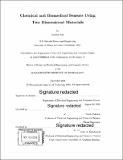| dc.contributor.advisor | Tomás Palacios. | en_US |
| dc.contributor.author | Xue, Mantian. | en_US |
| dc.contributor.other | Massachusetts Institute of Technology. Department of Electrical Engineering and Computer Science. | en_US |
| dc.date.accessioned | 2020-03-24T15:37:54Z | |
| dc.date.available | 2020-03-24T15:37:54Z | |
| dc.date.copyright | 2019 | en_US |
| dc.date.issued | 2019 | en_US |
| dc.identifier.uri | https://hdl.handle.net/1721.1/124282 | |
| dc.description | Thesis: S.M., Massachusetts Institute of Technology, Department of Electrical Engineering and Computer Science, 2019 | en_US |
| dc.description | Cataloged from PDF version of thesis. | en_US |
| dc.description | Includes bibliographical references (pages 73-82). | en_US |
| dc.description.abstract | We are at the onset of a revolution in chemical and medical sensors. Traditional sensors are bulky and difficult to use. Many researchers have started to build easy-to-use in-home healthcare monitoring system such as wearable sweat sensors. In order to make such system practical, sensors need to combine high sensitivity, high selectivity, fast response time and small signal drift. The sensors also need to cover a wide range of recognizable chemicals and molecules. Two-dimensional materials are perfect candidate as next-generation sensing materials because of their unique electrical, optical, mechanical and chemical properties. In this thesis, the fabrication and device technology of state-of- the-art graphene-based chemical sensor was discussed. A new 2D materials patterning technology and various passivation approaches were also studied. By using these novel technologies, three types of sensing devices that aims to push the development of better healthcare monitoring system were developed. A graphene-based biosensor for ligand detection was made with high sensitivity and a wide span of detection range. Graphene sensor arrays coupled with various types of ion-selective membranes were also developed. High sensitivity, selectivity and reversibility were achieve for detection of ionized calcium, sodium and potassium in electrolyte. Finally MoS 2 were explored to amplify the signal and achieve high sensitivity at low concentration as well as an easier measurement scheme. All three sensors will serve as building blocks for the realization of next-generation chemical and biomedical sensor systems. | en_US |
| dc.description.statementofresponsibility | by Mantian Xue. | en_US |
| dc.format.extent | 95 pages | en_US |
| dc.language.iso | eng | en_US |
| dc.publisher | Massachusetts Institute of Technology | en_US |
| dc.rights | MIT theses are protected by copyright. They may be viewed, downloaded, or printed from this source but further reproduction or distribution in any format is prohibited without written permission. | en_US |
| dc.rights.uri | http://dspace.mit.edu/handle/1721.1/7582 | en_US |
| dc.subject | Electrical Engineering and Computer Science. | en_US |
| dc.title | Chemical and biomedical sensors using two dimensional materials | en_US |
| dc.type | Thesis | en_US |
| dc.description.degree | S.M. | en_US |
| dc.contributor.department | Massachusetts Institute of Technology. Department of Electrical Engineering and Computer Science | en_US |
| dc.identifier.oclc | 1145279313 | en_US |
| dc.description.collection | S.M. Massachusetts Institute of Technology, Department of Electrical Engineering and Computer Science | en_US |
| dspace.imported | 2020-03-24T15:37:53Z | en_US |
| mit.thesis.degree | Master | en_US |
| mit.thesis.department | EECS | en_US |
